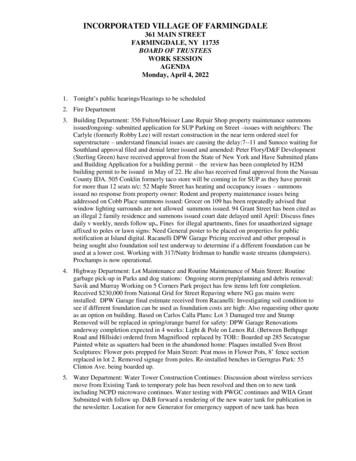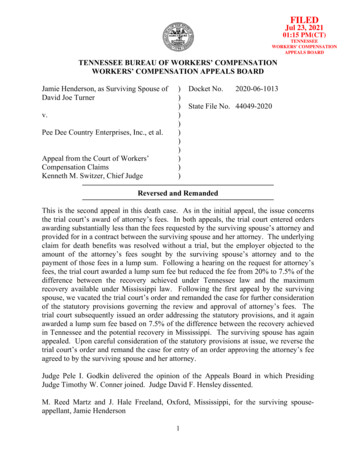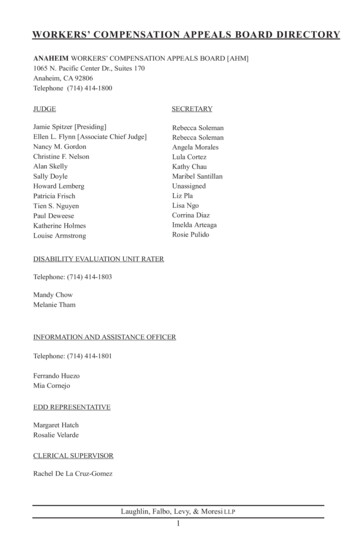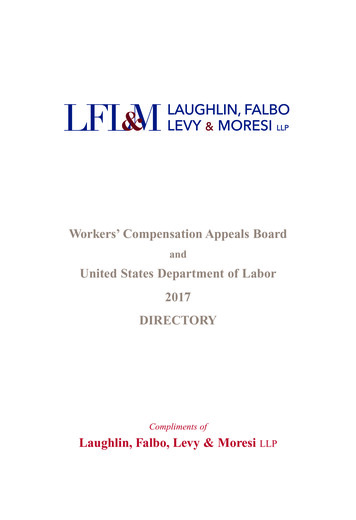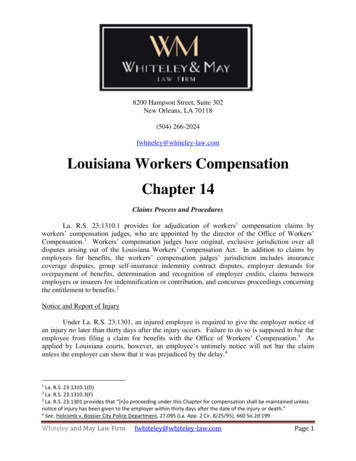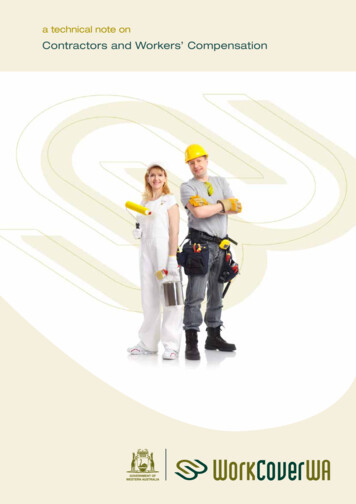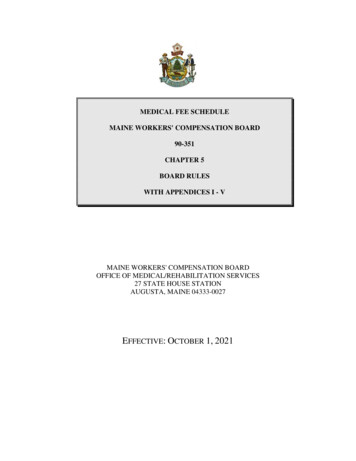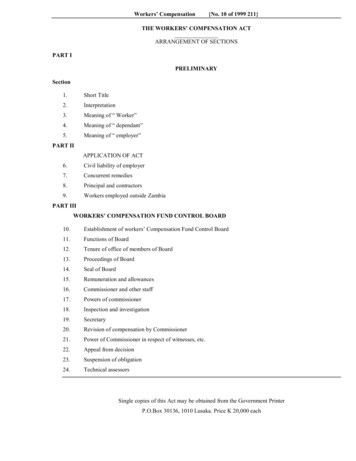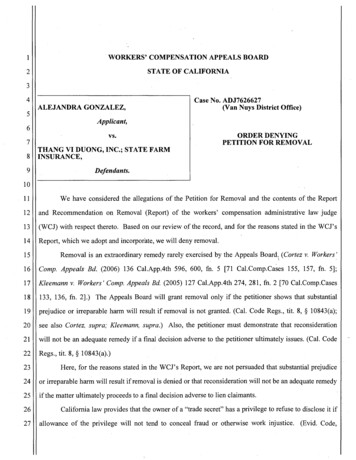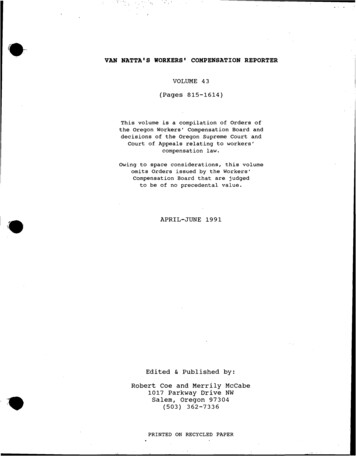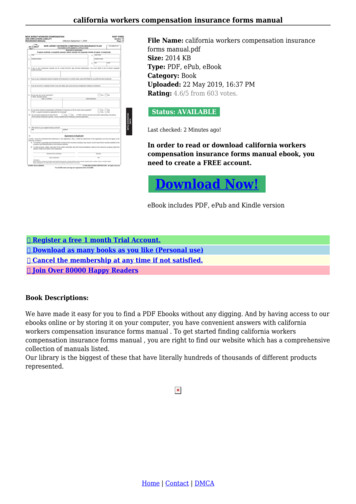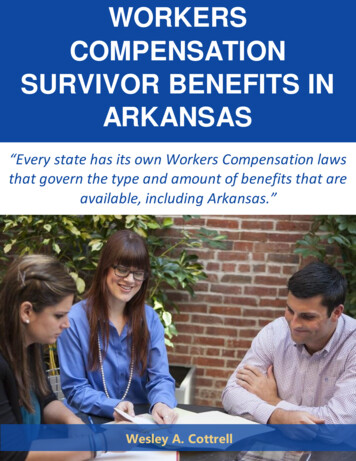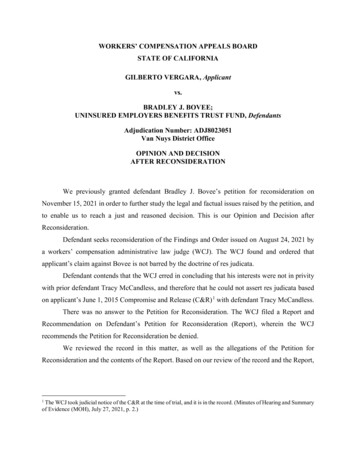
Transcription
WORKERS’ COMPENSATION APPEALS BOARDSTATE OF CALIFORNIAGILBERTO VERGARA, Applicantvs.BRADLEY J. BOVEE;UNINSURED EMPLOYERS BENEFITS TRUST FUND, DefendantsAdjudication Number: ADJ8023051Van Nuys District OfficeOPINION AND DECISIONAFTER RECONSIDERATIONWe previously granted defendant Bradley J. Bovee’s petition for reconsideration onNovember 15, 2021 in order to further study the legal and factual issues raised by the petition, andto enable us to reach a just and reasoned decision. This is our Opinion and Decision afterReconsideration.Defendant seeks reconsideration of the Findings and Order issued on August 24, 2021 bya workers’ compensation administrative law judge (WCJ). The WCJ found and ordered thatapplicant’s claim against Bovee is not barred by the doctrine of res judicata.Defendant contends that the WCJ erred in concluding that his interests were not in privitywith prior defendant Tracy McCandless, and therefore that he could not assert res judicata basedon applicant’s June 1, 2015 Compromise and Release (C&R) 1 with defendant Tracy McCandless.There was no answer to the Petition for Reconsideration. The WCJ filed a Report andRecommendation on Defendant’s Petition for Reconsideration (Report), wherein the WCJrecommends the Petition for Reconsideration be denied.We reviewed the record in this matter, as well as the allegations of the Petition forReconsideration and the contents of the Report. Based on our review of the record and the Report,The WCJ took judicial notice of the C&R at the time of trial, and it is in the record. (Minutes of Hearing and Summaryof Evidence (MOH), July 27, 2021, p. 2.)1
and for the reasons set forth below, it is our decision after reconsideration to affirm the F&O andreturn this matter to the trial level for further proceedings.BACKGROUNDThis claim was initially filed against Bovee, but McCandless was later joined as a potentialemployer. 2 (See Applications for Adjudication, October 12, 2011; July 8, 2013; and, February 11,2019 (Applications).) On June 1, 2015, a C&R was approved between applicant and defendantMcCandless. Bovee was not a party to the C&R. (C&R, p. 1.) The C&R states that the partiessettled applicant’s claim against McCandless in order to “avoid the costs, hazards and delays offurther litigation, and agreed that “a serious dispute” existed as to all issues, including the thresholdissue of whether applicant could be an employee of McCandless. (C&R, p. 7, ¶ 9, includingComments.)EMPLOYMENT PER LC 3352[(a)(8)] IS DISPUTED. DEFENDANTCONTENDS THAT APPLICANT WORKED INSUFFICIENT HOURS TOQUALIFY AS A RESIDENTIAL EMPLOYEE. THE PARTIES WISH TOAVOID THE HAZARDS OF FURTHER LITIGATION AND RESOLVETHIS CLAIM FOR A SUM CERTAIN. (Id., at Comments.) 3On February 11, 2019, the application was further amended to correct the address forBovee, and on December 2, 2019, Bovee entered an appearance in the case (Answer, December 2,2019).Trial then proceeded on July 27, 2021 regarding the sole issue of “Res judicata based onthe Compromise and Release and Order Approving of June 1, 2015.” (Minutes of Hearing andSummary of Evidence (MOH), July 27, 2021, p. 2.) Applicant testified that he was injured onMay 11, 2011 while working on a roof for Bovee. (Id., p. 3.) The roof was owned by a womannamed McCandless. (Ibid.) He agreed to the C&R even though he did not think it was faircompensation because of legal advice that there was an issue related to the amount of hours heAlso, applicant petitioned to join and the WCJ ordered joinder of the Uninsured Employer’s Benefits Trust Fund(UEBTF), on March 12, 2020 based on the allegation that there was no evidence that Bovee had workers’compensation insurance on the date of injury per the WCIRB. (See Petition to Join UEBTF, March 12, 2020; OrderJoining UEBTF, March 12, 2020.) UEBTF should therefore be included in the caption/title of this case.2Section 3352 was amended effective July 1, 2018, and subdivision (h) was replaced with subdivision (a)(8)(hereinafter section 3352(a)(8)).32
worked for McCandless, and that he would be able to recover additional benefits from UEBTFand Bovee. (Ibid.)The WCJ found that applicant’s claim against Bovee is not barred by the doctrine of resjudicata. (F&O, Findings of Fact no. 3.)Here, the issue for adjudication before the court is identical as it relates tolitigation of the same workers’ compensation case herein. The Order ApprovingC&R was a final judgment. A court approved settlement acts as a final judgmenton the merits for the purposes of res judicata. Id. at 694. That leaves the court toaddress the issue of privity, as Bovee was not a party to the C&R. Res judicataapplies when a party in the second action is in privity with a party to the firstaction. There is no prevailing definition of privity that automatically applies toall cases involving res judicata. Although “privity is a concept not readilysusceptible of uniform definition, the concept has been expanded to refer to suchan identification in interest of one person with another as to represent the samelegal rights’.” Rinaldi v. Workers’ Comp. Appeals Bd., 199 Cal. App. 3d 217,224 (citing Clemmer v. Hartford insurance Co. (1978) 22 Cal.3d 865,875).Here, there is no evidence to support that Bovee, an alleged employer of theApplicant was in privity with McCandless the homeowner with whom hecontracted to provide roofing services. The facts do not support that Bovee couldhave controlled the action herein. Moreover, his interests could not adequatelybe represented by McCandless, since it is axiomatic that the dispute ofemployment was uniquely different to both parties. Finally, there is no evidencethat Bovee is a successor in interest to McCandless, the homeowner. Therefore,the doctrine of res judicata does not apply to Bovee who was not a patty to theC&R and is not in privity with McCandless.In its trial brief, Defendant argues that Applicant is precluded from proceedingagainst Bovee since it is undisputed that there was the existence of a general andspecial employment situation as between the Applicant, McCandless, andBovee.Here, however, there has been no finding of dual employment in the form of ageneral or special employment relationship nor has there been any evidence tosupport same. . (F&O, Opinion on Decision, pp. 5-6.) 4The WCJ is correct that there has been no finding of dual employment in this case. However, the WCJ also includedhis opinion that “the evidence supports that McCandless was not an employer” pursuant to section 3352(a)(8). (F&O,Opinion on Decision, p. 6.) However, the issue of whether McCandless was applicant’s employer, under any theory,has never been adjudicated or determined. Should it be determined that the issue of whether McCandless wasapplicant’s employer is relevant in this matter, that issue can then be adjudicated and determined.43
Bovee seeks reconsideration on two fronts: first, that “Bovee was a party to the sameworkers’ compensation case, and the C&R resolved all issues in dispute by the applicant;” and,second, that pursuant to Castillo, Bovee was in privity with McCandless. (Petition forReconsideration, pp. 3-4.)The WCJ filed a Report recommending that the Petition for Reconsideration be denied:The undersigned finds that Castillo is distinguishable from the instant matter.First, in Castillo, there was no dispute that the parties were joint employers.There has been no such finding in the instant case. . Next, the undersigned doesnot interpret the subject matter of the litigation to be comparable with the causeof action or issued settled in the C&R. It is this court’s opinion that an analysisof ‘subject matter’ as referred to by Castillo has to do practically with theinterdependence of the relationship with respect to the subject matter. TheCastillo court itself notes that the analysis must be practical. Castillo supra at277.In Castillo, the court notes that Glenair and GCA were in privity for presentpurposes based on “both their interdependent relationship with respect topayment of the Castillos’ wages as well as on the fact that this litigation revolvesaround alleged errors in the payment of the Castillo’s wages.” Id. at 280(emphasis is added). There is no evidence to support any such interdependencebetween McCandless and Bovee. Based on the facts, McCandless was ahomeowner who hired Bovee to do roofing work on her home and subsequentlyfound herself joined to the action after Mr. Bovee failed to enter an appearancein the case almost two years later. Applicant testified at trial that he was hiredby Bovee and considered Bovee to be his employer.Defendant did not present any evidence or testimony to support anyinterdependence between McCandless and Bovee. As such, even under a subjectmatter analysis, the undersigned does not find the parties were in privity.Defendant cites to this WCJ’s citing of an employment dispute as between theparties. This was but one factor supporting a lack of interdependence and thatthe parties’ interests were at odds with one another. Moreover, if the parties werein privity as alleged, Defendant could have presented McCandless as a witness.Instead, the only argument presented to support the parties were privies is thatthe subject matter is the same. Moreover, the Castillo court also defined privityas “the sharing of ‘an identity or community of interest,’ with ‘adequaterepresentation’ of that interest in the first suit, and circumstances such that thenonparty ‘should reasonably have expected to be bound’ by the first suit.Castillo supra at 277.The issue in question here is the settlement between McCandless and Bovee.These negotiations would not have included the interests of Bovee since he wasnot a party to the settlement nor would Bovee have anticipated ‘to be bound’ by4
the settlement agreement between McCandless and the Applicant. Had theparties intended to release liability for Bovee in this matter, they would havedone so in the C&R. (Report, pp. 6-7.)We agree with the finding of the WCJ that applicant’s claim against Bovee is not barredby claim preclusion or issue preclusion. 5DISCUSSIONI.Bovee’s first contention is that the C&R released both McCandless and Bovee becausethey were both parties in the same workers’ compensation claim, and therefore the C&R “resolvedall issues in dispute.” (Petition for Reconsideration, p. 3.)The settlement in this case finally adjudicated disputes related to: employment,injury AOE/COE, temporary disability, parts of body injured, the need for futuremedical care and entitlement to supplemental job displacement benefits, amongothers, these points of exposure were the same depending on who would havebeen finally adjudicate to be the applicant’s employer. Instead of litigating thisdispute, the applicant elected to “ . avoid the hazards of further litigation andresolve this claim for a sum certain”. [sic] (Id., p. 4.)By this, Bovee could be arguing that the “primary rights” doctrine applies to preventapplicant from seeking workers’ compensation benefits from multiple employers. (DKN, supra,61 Cal.4th at p. 818 and fn. 1.) This would be a fundamental misunderstanding of how liabilityarises in workers’ compensation cases, as well as a misapprehension of the doctrine of claimpreclusion.“[W]ether an employer is liable for a coemployer’s violations depends on the scope of theemployer’s own duty under the relevant statutes, not ‘principles of agency or joint and severalliability.’” (Serrano v. Aerotek, Inc. (2018) 21 Cal.App.5th 773, 784 [2018 Cal.App. LEXIS 243],overruled in part on other grounds in Donohue v. AMN Services, LLC (2021) 11 Cal.5th 58, 77.)“We have sometimes described ‘res judicata’ as synonymous with claim preclusion, while reserving the term‘collateral estoppel’ for issue preclusion. (See Mycogen Corp. v. Monsanto Co. (2002) 28 Cal.4th 888, 896 [123 Cal.Rptr. 2d 432, 51 P.3d 297] (Mycogen).) . To avoid future confusion, we will follow the example of other courtsand use the terms ‘claim preclusion’ to describe the primary aspect of the res judicata doctrine and ‘issuepreclusion’ to encompass the notion of collateral estoppel.” (DKN Holdings LLC v. Faerber (2015) 61 Cal.4th813, 824 [2015 Cal. LEXIS 4652] (DKN), emphasis added.) We follow the Supreme Court’s direction and hereafterrefer to res judicata as claim preclusion and collateral estoppel as issue preclusion.55
Plaintiffs have identified no authority for the proposition that a joint employermay be held liable for Labor Code violations committed by a cojoint employerbased on principles of agency or joint and several liability. Rather, whether anemployer is liable under the Labor Code depends on the duties imposedunder the particular statute at issue. (Noe v. Superior Court (2015) 237Cal.App.4th 316, 333-334 [80 Cal.Comp.Cases 534], emphasis added; accord,Serrano, supra.)An employer’s duty to provide workers’ compensation benefits arises from Labor Codesection 3600 6, which states that in cases where the “conditions of compensation” are present,“[l]iability for the compensation provided by this division.shall, without regard to negligence,exist against an employer for any injury sustained by his or her employees arising out of and in thecourse of the employment.” (Lab. Code, § 3600.) This duty to provide compensation applies toany and all employers of the injured worker, and their liability is joint and several. 7“[C]laim preclusion applies only to the relitigation of the same cause of action between thesame parties or those in privity with them.” (DKN, supra, 61 Cal.4th., at p. 825, emphasis in theoriginal.) Bovee was not a party to the C&R, nor in privity with McCandless: “[j]oint and severalliability alone does not create such a closely aligned interest between co-obligors [for privity]. Theliability of each joint and several obligor is separate and independent, not vicarious or derivative.”(DKN, supra, 61 Cal.4th at p. 826, emphasis added.) Therefore, and contrary to Bovee’s apparentcontention, whether applicant’s claims “involve the same primary right is beside the point.(citation)” (Ibid.) “[J]oint and several liability does not implicate the “primary rights” doctrine.”(Id., at p. 818.) “This conclusion is entirely consistent with the settled rule that joint and severalobligors may be sued in separate actions. (citation).” (Ibid.)In other words, multiple employers may be named in the same claim without destroyingtheir joint and several obligation to provide applicant with workers’ compensation benefits. Thus,unless Bovee was a party or in privity with a party to the C&R, Bovee cannot assert the C&R tobar applicant’s claim – even though the claim made against both employers is the same.6All further references are to the Labor Code unless otherwise noted.Liability between multiple employers in a workers’ compensation claim is joint and several. In workers’compensation, “several liability.is a procedural right that promotes the public policy favoring expeditious andinexpensive resolution of workers’ compensation claims by enabling a claimant to obtain compensation withouthaving to join multiple co-obligors.” (California Ins. Guarantee Assn. v. Workers’ Comp. Appeals Bd. (Lopez) (2016)245 Cal.App.4th 1021, 1029 [81 Cal.Comp.Cases 317].) Although co-obligors may seek to apportion liability betweenthemselves, this “is of no moment to the worker.and can have no effect on obligations owed them.” (Ibid.)76
Bovee could also be arguing that the C&R should act to bar “relitigation” of those issuescontemplated by the C&R. This would be a request to impose issue preclusion against Bovee forall issues contemplated in the C&R.In summary, issue preclusion applies (1) after final adjudication (2) of anidentical issue (3) actually litigated and necessarily decided in the first suitand (4) asserted against one who was a party in the first suit or one in privitywith that party. (citations)” (Faerber, supra, 61 Cal.4th at pp. 824-825, emphasisadded.)There are no grounds to impose issue preclusion as to any of the issues contemplated bythe C&R. Although the C&R is a final adjudication of applicant’s claim against McCandless,including common issues related to workers’ compensation benefits, it was certainly not a finaladjudication of issues “actually litigated and necessarily decided.” (Ibid.) “It is the opportunityto litigate that is important in these cases.” (Rymer v. Hagler (1989) 211 Cal.App.3d 1171, 1179[1989 Cal.App. LEXIS 663].)Here, the C&R specifically states that the parties, i.e., applicant and McCandless, settledevery issue in applicant’s claim against McCandless in order to “avoid the costs, hazards anddelays of further litigation, and agree that a serious dispute exists” as to various issues, includingthe threshold issue of employment itself. (C&R, p. 7, ¶ 9, including Comments.) Bovee admits thisby stating that applicant chose to resolve his claim against McCandless, “[i]nstead of litigating thisdispute.” (Petition for Reconsideration, p. 4.)Thus, the C&R does not represent a final adjudication of any issue in this case, and cannotbe used to bar litigation of any issue related to his claim against Bovee.II.Bovee contends that regardless, he was in privity with McCandless and therefore, the C&Racts to bar applicant’s claim against him.Claim preclusion “prevents relitigation of the same cause of action in a secondsuit between the same parties or parties in privity with them.” (Mycogen, supra,28 Cal.4th at p. 896.) Claim preclusion arises if a second suit involves (1) thesame cause of action (2) between the same parties (3) after a final judgmenton the merits in the first suit. (citations) If claim preclusion is established, itoperates to bar relitigation of the claim altogether. (DKN, supra, 61 Cal.4th at p.824, emphasis added.)7
Both Bovee and McCandless were named as employers in the same workers’ compensationclaim, and the C&R does represent a final adjudication of applicant’s claim against McCandless.However, the C&R was not between the “‘same parties or parties in privity with them.’” (Ibid.)[P]rivity requires the sharing of “an identity or community of interest,” with“adequate representation” of that interest in the first suit, and circumstances suchthat the nonparty “should reasonably have expected to be bound” by the firstsuit. (Clemmer v. Hartford Insurance Co. (1978) 22 Cal.3d 865, 875 [151 Cal.Rptr. 285, 587 P.2d 1098].) A nonparty alleged to be in privity must have aninterest so similar to the party’s interest that the party acted as the nonparty’s“‘“virtual representative”’” in the first action. (Gottlieb v. Kest (2006) 141Cal.App.4th 110, 150 [46 Cal. Rptr. 3d 7].) (DKN, supra, 61 Cal.4th at p. 826.)Bovee was not a party to the C&R, and is there is no evidence or contention that Boveeand McCandless are legally the “same party,” eg., principal and agent, corporation and employee,etc. (See DKN, supra, 61 Cal.4th at pp. 827-828.) Bovee could therefore have no expectation to bebound by the C&R, and certainly, the C&R could never have been enforced by applicant againstBovee.There is also no evidence that Bovee was in privity with McCandless. Although not yetdetermined in this case, it could be that Bovee, McCandless, or both Bovee and McCandless maybe found to be employers. As already stated above, if both are found to be employers, their liabilitywill be joint and several. Contrary to Bovee’s argument below, “[j]oint and several liability alonedoes not create such a closely aligned interest between co-obligors [for privity]. The liability ofeach joint and several obligor is separate and independent, not vicarious or derivative.” (DKN,supra, 61 Cal.4th at p. 826, emphasis added.) 8 This is consistent with the purpose of the workers’compensation system to ensure an injured worker receives “‘full provision for such medical,surgical, hospital and other remedial treatment as is requisite to cure and relieve from the effectsof such injury.’ (Fitzpatrick v. Fidelity & Casualty Co. (1936) 7 Cal. 2d 230, 233 [60 P.2d 276].)”(Sea-Land Serv. v. Workers' Comp. Appeals Bd. (1996) 14 Cal.4th 76, 85 [61 Cal.Comp.Cases1360]; see Cal Const, Art. XIV § 4.)The only exception to this rule involves the statutory right of a special employer to exclude from its workers’compensation insurance coverage all special employees when there are assurances that the general employer hascoverage for those employees. (See Travelers Property Casualty Co. of America v. Workers’ Comp. Appeals Bd.(2019) 40 Cal.App.5th 728 [84 Cal.Comp.Cases 883].) The duty – or liability of the general employer for injuries tothe special employees, and the lack of duty for the special employer to do so, arises from a statute, i.e., Insurance Codesection 11663 and section 3602, subdivision (d).88
Next, each employer has the burden of proof to establish its own defense to liability. 9 As aresult, “[o]ne named employer could avoid liability for benefits by pursuing a factual defense eventhough that defense leaves the other named employer exposed to liability.” (Grande v. EisenhowerMedical Center (2020) 44 Cal.App.5th 1147, 1160 [2020 Cal.App. LEXIS 96], review granted,Grande v. Eisenhower Medical Center (Nov. 24, 2020, No. S261247) Cal.5th [2020 Cal.LEXIS 8183], citing Serrano, supra, 21 Cal.App.5th 773.) In fact, this is what happened in thiscase. Applicant testified, and the C&R expressly states, that McCandless raised a defense to herliability based on section 3352(a)(8), which states in summary, that residential employees mustwork at least 52 hours in the 90 days preceding an injury. (Lab. Code, §§ 3351, 3352(a)(8); seeLab. Code, § 2750.5 and Cedillo v. Workers’ Comp. Appeals Bd. (2003) 106 Cal.App.4th 227, 235[68 Cal.Comp.Cases 140].) Applicant testified that one of the reasons he settled againstMcCandless was because he worked insufficient hours to qualify as her employee. (Lab. Code,§ 3351, 3352, 2750.5.) 10However, this defense is arguably not available to Bovee, and the successful leverage ofsection 3352(a)(8) by McCandless leaves Bovee exposed to liability for the entire claim. (SeeCedillo, supra, 106 Cal.App.4th at p. 236.) “The difference in incentives precludes finding thecompanies are adequate representatives for privity purposes.” (Grande, supra, 44 Cal.App.5th atp. 1160.)We therefore affirm the decision of the WCJ that applicant’s claim against Bovee is notbarred by claim preclusion based on the C&R.“‘[T]he fact that one is performing work and labor for another is prima facie evidence of employment and suchperson is presumed to be a servant in the absence of evidence to the contrary.’” (Narayan v. EGL, Inc. (9th Cir. 2010)616 F.3d 895, 900 [75 Cal.Comp.Cases 724] quoting Robinson v. George (1940) 16 Cal.2d 238, 241 [5Cal.Comp.Cases 233].) “Once the presumption of employment comes into play, the burden shifts to the employer toestablish that the injured person was an independent contractor or otherwise excluded from protection under theWorkers’ Compensation Act. [citations omitted]” (Barragan v. Workers’ Comp. Appeals Bd. (1987) 195 Cal.App.3d637, 642 [52 Cal.Comp.Cases 467].)9Please note that we are not commenting, or making any sort of finding that the defense raised by McCandless wasever adjudicated or determined. However, applicant’s testimony and the statement made in the C&R related to section3352(a)(8), are evidence that the C&R was reached in part because of the potential of that defense.109
III.Bovee cites to Castillo v. Glenair, Inc. (2018) 23 Cal.App.5th 262 [2018 Cal.App. LEXIS459] to support his contention that he was in privity with McCandless. 11 However, Castillo islegally inapposite because the dispute involved liability between employers in a wage and hourclaim, which is governed by Division 2 of the Labor Code (Employment Regulation andSupervision). (Castillo, supra, 23 Cal.App.5th at p. 266-267.) This is a workers’ compensationcase, where the definitions of employee and employer, and the determination of liability betweenemployers is governed by Division 4 of the Labor Code. (Eg., see Lab. Code, § 3350; see alsoDynamex v. Operations W. Inc. v. Superior Court (2018) 4 Cal.5th 903 [83 Cal. Comp. Cases817].) Indeed, the Court in Castillo stated as much:To be clear, however, our conclusion does not necessarily place Glenair andGCA in privity for all purposes. By way of example only, if the Castillos wereto allege claims against Glenair based on injuries they sustained ordiscrimination they experienced while working at Glenair, it is by no means aforegone conclusion that GCA would be in privity with Glenair in that case.In such a case, it is not clear that Glenair and GCA would share the samerelationship to the subject matter of the litigation. In contrast here, becausethe subject matter of the litigation directly implicates the interdependent andclose relationship of Glenair and GCA with respect to payment of wages, theyare in privity for present purposes. (Castillo, supra, 23 Cal.App.5th at p. 280,emphasis added.)In addition, we agree with the WCJ that Castillo is clearly distinguishable on its facts, andas such, is not relevant as precedent in this case. 12 Castillo involves a wage and hour claim broughtby employees of a temporary staffing service and its client company. (Id., at p. 266-267.) TheWe note that Castillo has been directly questioned by at least one other District Court of Appeal for not applyingthe privity analysis required by the California Supreme Court’s decision in DKN. (See Grande, supra, 44 Cal.App.5that pp. 1162-1163 [“Respectfully, this is not the correct analysis. . If the person or entity seeking preclusive effect wasnot a party to the first litigation, we must then focus on their relationship to the party and the subject matter of thelitigation, asking whether their interests are so close to identical that the nonparty should have reasonably expected tobe bound by the prior judgment even though not a party. By focusing overmuch on whether the subject matter of thelitigation is the same, the Castillo court nearly collapses the second element (same parties) into the first (same claims).The court then justified finding a sufficiently close relationship on the fact that both companies were involved inpaying the plaintiffs their wages. That’s simply not a sufficient basis for finding a client and staffing agency to be inprivity. As the court explained in Serrano, a staffing agency and a client may both be “involved in” the payment ofwages, yet be independently liable for wage and hour violations. We therefore depart from the reasoning in Castillo,conclude FlexCare and Eisenhower were not in privity, and affirm the trial court.”].)11We remind the parties that when citing a case, they should explain the distinctions between the cited authority andthe case at issue. (Ayyad v. Sprint Spectrum, L.P. (2012) 210 Cal.App.4th 851, 862, fn. 5.)1210
Castillos brought a complaint against the client company for the same wage and hour claimspreviously litigated in a class action against the temporary staffing service company, which wassettled (the Castillos did not opt out of that settlement). (Ibid.) The terms of the settlementagreement released the temporary staffing service “and its agents.” (Id.)The Court found that the subsequent complaint against the client company was barred byclaim preclusion because the temporary staffing service and the client company were in privity.(Id., at p. 280.) Privity was found based on “their interdependent relationship with respect topayment of the Castillos’ wages as well as on the fact that this litigation revolves around allegederrors in the payment of the Castillo’s wages.” (Ibid.) The Court also found that the subsequentsuit was barred by claim preclusion because the client company was the agent of the temporarystaffing service, and therefore an expressly “released party” under the settlement agreement. (Id.,at p. 281.)Unlike the circumstances in Castillo, however, there is no evidence here that Bovee andMcCandless are the same party, or that there is the integration of interests between Bovee andMcCandless necessary for a finding of privity. Indeed, as previously discussed, their interests werein direct conflict. The only argument from Bovee on this point is that they were both named asemployers in the same workers’ compensation claim involving the same underlying issues. Thisis essentially a duplicative argument. As stated above in section I., it appears that Boveemisapprehends how employer liability is established in workers’ compensation cases, and theelements required to establish claim preclusion. If both Bovee and McCandless are found to beemployers in this case, their duty, or liability to provide benefits will be defined by statute. (Eg.,Lab. Code, § 3600.)There is also no evidence in the record to support a finding that either Bovee or McCandlesswas the agent of the other, or that there were any terms in the C&R releasing Bovee from liabilityas an employer in this case. (See Castillo, supra, 23 Cal.App.5th at pp. 277-278 [Agency requiresevidence that authority has been expressly or impliedly granted to a party, the agent, to act for andin the place of the principal in legal relationship with third parties, i.e., not the agent or principal.].)Accordingly, as there is no evidence in the record to support Bovee’s contention thatapplicant’s claim should be barred by claim preclusion or issue preclusion, it is our decision afterreconsideration to affirm the F&O and return this matter to the trial level for further proceedings.11
For the foregoing reasons,IT IS ORDERED as the Decision after Reconsideration of the Workers’ CompensationAppeals Board that the Findings and Order issued on August 24, 2021 by a workers’ compensationadministrative law judge is AFFIRMED and this matter is RETURNED to the trial level forfurther proceedings.WORKERS’ COMPENSATION APPEALS BOARD/s/ MARGUERITE SWEENEY, COMMISSI
Van Nuys District Office . OPINION AND DECISION . On February 11, 2019, applicthe ation was further amended to correct the address for Bovee, and on December 2, 2019, Bovee entered an appearance in the case (Answer, December 2, . WORKERS' COMPENSATION APPEALS BOARD .
